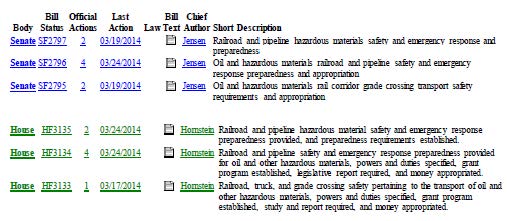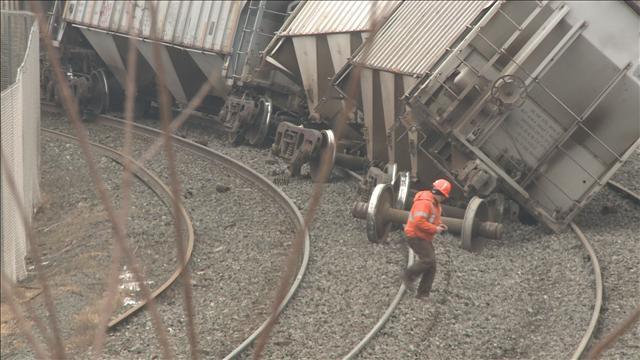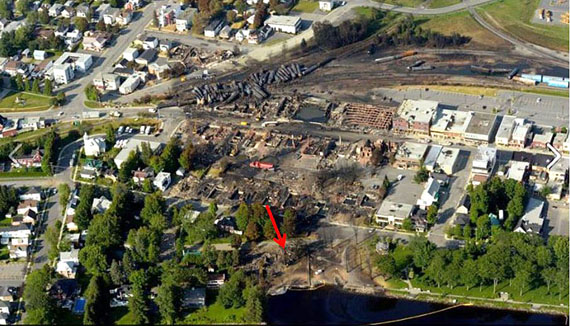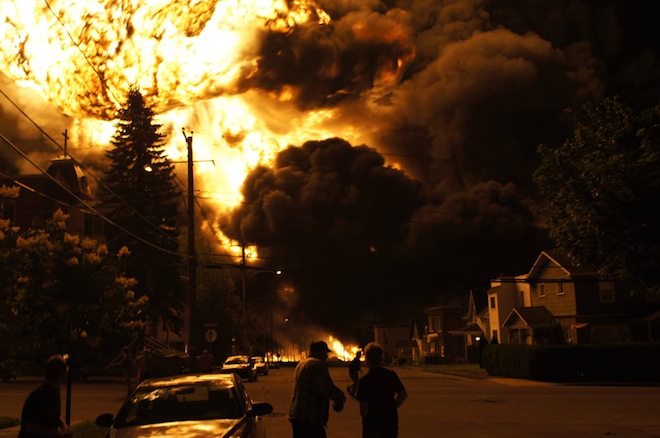Dayton bellyflops into the frac sand fracas
April 22nd, 2014
Gov. Tim Pawlenty was the “Green Chameleon,” but Gov. Mark Dayton doesn’t even pretend to be green. Today, he showed his true colors, delivering a harsh undercutting “rebuff” of a statement just prior to petitions being delivered to his office, petitions with 6,000 signatures, obtained with a lot of effort from a lot of citizens, requesting he enact a moratorium to stop new frac sand mines in Southeast Minnesota. To deliver this message in the way that he did says a lot for his regard for his constituents and their concerns. How hard would it have been to meet with those delivering the Petitions, to graciously accept them, and at least consider the request, take it under advisement?
I sure hope everyone is talking about our Governor. WOW!
6,000 signatures… how many does it take for a recall election?!?!?!?!
Here’s his statement:
++++++++++++++++++++++++++++++
As for the “Critical Areas Act” as the basis for a moratorium, well, I’m not so sure about that… There are a few steps that have to happen before it goes to the Governor. Minn. Stat. 116G.06.
Here’s where you can tell him directly what you think of his treatment of concerned Minnesotans:
Telephone: 651-201-3400
Toll Free: 800-657-3717
The report on MPR:
Dayton says no to frac sand moratorium
The report in the STrib:
Dayton says no to frac sand moratorium in southeastern Minn.
Says he lacks authority for the southeastern Minnesota ban sought by mining opponents
Bakken BOOM and rail safety
April 17th, 2014
There are more and more aspects of rail safety coming into question as people learn about life with the many Bakken oil trains rolling through our communities.
What about the greatly increased air emissions due to the increased rail traffic? Locomotive emissions are regulated:
The short version, from the EPA:
General Information
- Fact Sheet: Control of Emissions from Idling Locomotives (PDF) (4 pp, 143K, EPA-420-F-13-050, December 2013)
- Fact Sheet: Federal Preemption of State and Local Standards for Locomotives (PDF) (3 pp, 11K, EPA420-F-97-050, December 1997)
- Summary of emission standards
That regulates individual locomotives, but how are the cumulative impacts of so many trains addressed, particularly in the Mississippi River Valley, the “land of inversions?”
There’s continued talk about the new DOT111 rail cars, but how will that address the problem of volatility, that the Bakken crude contains a much higher level of gas than other crude, and that although regulators have said that the Bakken crude should be degasified before it is shipped, whether by rail or pipeline, this is not yet incorporated into standard practice. And it bears repeating — this is an issue for Bakken crude in pipelines! Pipelines are not a miracle cure for the Bakken crude volatility problem!
It can happen here. It has happened here. It will happen here. What do we do to protect ourselves?
This is a train incident in September, 2013 just across the river in Hager City, WI:
And in Red Wing:
A Wisconsin town’s fire chief was part of a discussion with U.S. Rep. Ron Kind recently regarding rail safety. The station is one block from the river and the railroad tracks. Congressman Kind asked the fire chief what the impact of a Bakken oil wreck would be on his community, if the fire unit could respond, and the fire chief said, “I doubt it, we’d be vaporized.”
If a Lac Megantic level explosion occurred in Red Wing, presuming that buildings two blocks from the explosion would be leveled, and maybe three blocks, it would reach to Main Street, and perhaps the block beyond:
This is how it is in all the communities along the Mississippi River, a disaster waiting to happen for us, for the River.
There’s a reason it’s called the “Bakken Boom.” BOOM!
And in the La Crosse Tribune:
Meeting set on rail expansion
plan
5 hours ago • BETSY BLOOM bbloom@lacrossetribune.com
Hornstein/Jensen Bakken oil rail safety bills
March 25th, 2014
Rep. Frank Hornstein and Sen. Vicki Jensen have introduced three bills related to rail safety, triggered by the recent Bakken oil rail car derailments and explosions.
 Here’s a pdf with clickable links to check out the specific language and status:
Here’s a pdf with clickable links to check out the specific language and status:
TO DO: Contact House Committee members and urge passage:
In the House, all the bills have been referred to Transportation Finance (HF 3134 after a trip through the Transportation Policy and Public Safety committees), so now we’ve got to contact those in Transportation Finance to move HF 3133, HF 3134 & HF 3135 on to the House floor — it’s Frank’s committee so he shouldn’t have any trouble getting a hearing!!! Contact info for House Finance members HERE!
TO DO: Contact Senate Committee members and urge passage:
In the Senate, two have been referred to Transportation and Public Safety (SF 2795 and SF 2796), and one to Environment and Energy (SF 2797). Contact info for Transportation and Public Safety HERE! Sen. Scott Dibble is Chair so there should be no problem getting a hearing here either!! Contact info for Environment and Energy HERE!
Senate Transportation and Public Safety Committee will hear them tomorrow:
Wednesday, March 26, 2014
Committee on Transportation and Public Safety
Chair: Sen. D. Scott Dibble
03:00 PM
Room 15 Capitol
Something very noticeable here in this district is that Rep. Matt Kelley and Rep. Steve Drazkowski have not signed on. ???? This is a huge issue for those of us along the Mississippi with the rail line running right through town.
TO DO: Contact these legislators along the tracks and urge them to sign on (and also those towards Fargo too, don’t know where the train runs there):
Reps: rep.tim.kelly@house.mn (21A); rep.steve.drazkowski@house.mn (21B); rep.gene.pelowski@house.mn (28A); rep.greg.davids@house.mn (28B); rep.pat.garofalo@house.mn (58B).
Senators: sen.jeremy.miller@senate.mn (28); sen.dave.thompson@senate.mn (58).
Why aren’t state Representatives and Senators in SE Minnesota acting on this explosive issue?
Here are notes from a City of Red Wing meeting with CP on March 17th:
Someone explain rulemaking to the MPCA
March 2nd, 2014
The Minesota Pollution Control Agency (MPCA) is in charge of organizing the three rulemakings mandated by last year’s silica sand bill, and it’s really not that complicated — narrow specific issues. From the Session Law, here’s what they’re supposed to do.
Sec. 105. RULES; SILICA SAND.
(a) The commissioner of the Pollution Control Agency shall adopt rules pertaining to the control of particulate emissions from silica sand projects. The rulemaking is exempt from Minnesota Statutes, section 14.125.
(b) The commissioner of natural resources shall adopt rules pertaining to the reclamation of silica sand mines. The rulemaking is exempt from Minnesota Statutes, section 14.125.
(c) By January 1, 2014, the Department of Health shall adopt an air quality health-based value for silica sand.
(d) The Environmental Quality Board shall amend its rules for environmental review, adopted under Minnesota Statutes, chapter 116D, for silica sand mining and processing to take into account the increased activity in the state and concerns over the
size of specific operations. The Environmental Quality Board shall consider whether the requirements of Minnesota Statutes, section 116C.991, should remain part of the environmental review requirements for silica sand and whether the requirements should be different for different geographic areas of the state. The rulemaking is exempt from Minnesota Statutes, section 14.125.
Do notice that each directive for rulemaking says that “The rulemaking is exempt from Minnesota Statutes, section 14.125.” That’s code words for “take your time, we’re in no hurry to see anything accomplished. Dawdle, go around in circles, fall down, and get lost along the way…” Folks, that’s just what we’re experiencing in this rulemaking process, molasses on a cold day in hell.
Initially, the MPCA resisted forming an Advisory Committee. Those of us who’ve participated in rulemaking before know that the Advisory Committee is where it happens, where you can have some meaningful input, because in the world of rulemaking, you can’t adopt a rule that is substantially different than that offered for comment by the agency. Therefore has to happen at the draft stage, before the agency releases it. But this MPCA is the same MPCA that worked very hard to avoid having a Citizen’s Advisory Committee, despite it being expressly authorized by statute. Once more, with feeling:
MPCA staff’s report to the EQB stated inexplicably that they were “confused,” claiming ignorance of how rulemakign works and the impact of comments at this stage:
i. Staff requests Board direction on a question that arose at the August 2nd public meetings.
Members of the public expressed interest in a citizen committee to participate in the rulemaking. It is not clear how a citizen committee would affect the rulemaking process laid out in Minn. Statutes Ch. 14. A multi-step public review and comment process is already required in that statute and we just completed the preliminary step. Rulemaking is essentially creating law: Minnesota Rules have the force and effect of law. Rulemaking is a lengthy process, averaging about two years.
As I said in comments prior to, during, and after the meeting, “It is not clear…” NO NO NO! For someone in Smyser’s position, there’s no excuse for statements like this. The statute is very clear about the agencies’ authority to appoint an Advisory Committees and how an advisory committee it would affect rulemaking – it improves the output by providing input before the draft rule is issued.
CLICK HERE FOR STATUTES ON RULES
CLICK HERE FOR RULES ON RULES (don’t worry, it’s not a mobius strip), 1400.2000 – 1400.2570.
Here’s how the Dept. of Health explains the role of Advisory Committee members (link to their entire Rulemaking Manual below, it could be helpful for those stuck in this molasses process, yes this is about Health, but the intrinsic role and function of an Advisory Committee remains the same):
And now, about ten months after the legislation was passed, TEN MONTHS, rulemaking is flailing about, there is no language proposed, and staff has no language. What’s going on? My money is on one path — that they’ll stall and bamboozle with bullshit and take in a few general comments, and then hand the draft rule that they want, without any draft, without any review by the Committee, to the agency to issue a SONAR, Notice and put out for public comment, totally blowing off the Citizens Advisory Committee.
Whatever their intent, the impact is that tempest is a fugiting and there’s nothing to show for the time slowly ticking away.
Why would I say such a thing? First, again, there is no draft language for the Committee to review. None, nada, nothing for any of the three rules they’re charged with drafting. So what exactly are they doing?
Second, they are for sure bamboozling them with bullshit, because look what’s posted as materials, from the Silica Sand Advisory Panel page:
Resources for the panel and the public
Reports
Air monitoring data for industrial sand mine/processing plants in Wisconsin
Report on Silica Sand (2013)
[DRAFT] Tools to assist local governments in planning for and regulating silica sand projects
Rulemaking
Charting your course – Basic rulemaking
MDNR – Silica sand rulemaking: reclamation
Minn. Rules 4410 – Environmental Review
Minn. Rules 7009 – Minnesota Ambient Air Quality Standards
Minnesota Rulemaking Manual and Seminar
MPCA rulemaking for silica sand projects
Overview of Minnesota formal rulemaking process
Information sources
Air monitoring at Minnesota silica sand facilities
General geospatial information on natural resources
Silica sand mining and health
Other
Federal – Compliance Assurance Monitoring
Federal – State Implementation Plan for Minnesota (SIP)
Minnesota – Emission Inventory Requirements
Minnesota – Performance Testing
Existing rules
Environmental Quality Board
Minn. Rules 4410 – Environmental Review
Air: State and federal
Federal – Ambient Air Quality Standards
Minnesota – Ambient Air Quality Standards
Definitions and Abbreviations
Federal – Compliance Assurance Monitoring
Federal – State Implementation Plan for Minnesota (SIP)
Minnesota – Emission Inventory Requirements
Minnesota – Performance Testing
Federal – Standards of Performance for Calciners and Dryers in Mineral Industries
Federal – Standards of Performance for Nonmetallic Mineral Processing Plants
Minnesota – Adopts and incorporates by reference 40 CFR pt. 60, subp. OOO
Minnesota – Direct Heating Fossil-Fuel-Burning Equipment
Minnesota – Emission Standards for Visible Air Contaminants
Minnesota – Fugitive Emissions
Minnesota – Indirect Heating Fossil-Fuel-Burning Equipment
Minnesota – Industrial Process Equipment
Federal – “Title V / Part 70” Stationary Source Permit Program
Federal – New Source Review Program
Minnesota Air Permit Program
OH. MY. DOG.
Now honestly, can you look at that without getting dizzy? If all that crap doesn’t have Committee members, most or all of whom have no experience in rulemaking, ready to commit hari-kari, or go utterly insane, or both…
MPCA, just get to the rulemaking, give the public the draft language, so we can tell you what we think about it. Show us you’re not acting in bad faith.
D-R-A-F-T L-A-N-G-U-A-G-E!
Feel free to let them know what you think, what you expect of the rulemaking process, and what you want to see for the draft rules:
nathan.cooley@state.mn.us
Jeff.Smyser@state.mn.us
wendy.turri@state.mn.us
And in the alternative, methinks we’d best come up with some specific draft language now, if not sooner. Show ’em how it’s supposed to be done.
Caucus day today
February 4th, 2014
Minnesotans — CLICK HERE TO Find out where to attend your precinct caucus.
It’s caucus day today, and right now what’s humming around in my brain is the need for beefed up regulation of train traffic. There’s the exploding Bakken oil tankers, due to the increased volativity of the crude and need for degasification, and there’s the delay of Amtrak trains through North Dakota, putting people on BUSSES, because of the increased traffic. These are examples of how the rail system is NOT working.
Here are a few resolutions I’m putting in:
I’ve got a list of resolutions, growing by the minute:
- Ban use of polyacrylamide for mining processing in Minnesota (used in silica sand mining, also proposed for use at PolyMet).
- In the interest of public safety, Bakken crude oil must be properly tested, characterized, classified, and where appropriate sufficiently degasified prior to loading onto rail or truck tanker cars, or into pipelines, to identify potential hazards and degasified to lessen volativity prior to transport.
- Amtrak trains must be given priority over freight traffic, particularly through North Dakota, where currently trains are significantly delayed (hours), or passengers are put on busses to go around the oil train traffic.
- AMEND – delete garbage from definition of “renewable” energy sources:
216B.1691 RENEWABLE ENERGY OBJECTIVES.
Subdivision 1.Definitions.(a) Unless otherwise specified in law, “eligible energy technology” means an energy technology that generates electricity from the following renewable energy sources:
(1) solar;
(2) wind;
(3) hydroelectric with a capacity of less than 100 megawatts;
(4) hydrogen, provided that after January 1, 2010, the hydrogen must be generated from the resources listed in this paragraph; or(5) biomass, which includes, without limitation, landfill gas; an anaerobic digester system; the predominantly organic components of wastewater effluent, sludge, or related by-products from publicly owned treatment works, but not including incineration of wastewater sludge to produce electricity; and an energy recovery facility used to capture the heat value of mixed municipal solid waste or refuse-derived fuel from mixed municipal solid waste as a primary fuel.
- Repeal 216B.1694 INNOVATIVE ENERGY PROJECT.
The Excelsior Energy Mesaba Project was rejected by the Minnesota Public Utilities Commission and the statute should be repealed.
- Develop publicly available state registry of animal abusers, including those convicted of abuse, neglect and hoarding, identifying names, current address and address at time of conviction of those convicted, dates and charges, resolution, and contact information for probation officer.










